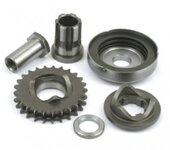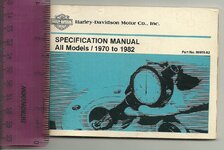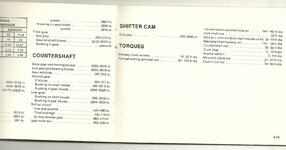You are using an out of date browser. It may not display this or other websites correctly.
You should upgrade or use an alternative browser.
You should upgrade or use an alternative browser.
Compensating sprocket
- Thread starter Boggy
- Start date
Paul P.
H-DRCGB Archivist
Shipley in mid-eighties, being helped by the old South Downers crew. After many years searching for an official torque figure (people keep reading the flywheel nut in the manual as the figure) I found it in a very rare factory pocket spec book, did it up at that figure and it undid on way up to rally. It also undid from this photo, asked Fred Warr what he used and he said impact socket with a scaffold tube! I used an inch drive socket and bar until Steve "Mo" Morris put me onto a Mini suspension tool, a Williams Superslim BLM024 which you use with a club hammer - it is the air gun you can carry with you! (in this photo I am using a monster WW2 surplus box spanner, probably out of the tool box of an "Ice Cold In Alex" ambulance)
Ron
Club Member
Once again I have my "not an engineer" head on. I thought that a left hand thread is used on a rotating shaft when a sudden stop of the shaft could cause the nut on the shaft to loosen. The clutch hub nut is like this but not the retainer on the compensator. Does anyone know the reason for this.Are you going the right way to undo as the compensator has a right hand thread and the clutch has a left hand thread so turn right to tighten and left to undo i tend to use a good 6 side socket with lever bar and a 3ft tube which shifts most of them unless someone’s been in and loc tighted the granny out of it then I use an impact gun
Ron.
SJC69
Club Member
The 'compensator' is a built in shock absorber in the primary drive, the sleeve nut as it was in the 'old days' holds the ramps and heavy spring together that acted as the shock absorber by enabling it to move on the ramps to dampen and smooth out shocks.
Right Hand Rotating shafts do not have to or are always have Left Hand threaded fasteners, it can be due to construction, materials, constraints etc. and the amount of torque that can actually be used to tighten the fastener.
A common L/H tread on a R/H rotating shaft is the Bicycle left hand pedal, you have around a 1/4 inch diameter steel thread into an aluminium crank tightened by two flats on the pedal shaft, you cannot physically get that much torque to secure the pedal without damage and as a result it will often come loose if a R/H thread is used due to the constant force of pedalling.
On the other side the right hand pedal will tighten up with a right hand thread due to the pedaling or at least that is the theory!
Now back to the compensator sleeve nut, this has a large head 1" 1/2 AF and thus clamping surface area and is made of steel, threaded internally with a large amount of threaded area that fixes to the steel end of the the crankshaft. A lot of torque can be applied ( & Loctite etc.) to that sleeve nut without damage to ensure it does not come loose.

When it was specified, the torque setting for this sleeve nut was around 150 to 200 ft/lbs plus, when not tightened up correctly they could and would come loose.
Now for the clutch nut, this would traditionally hold the clutch centre onto a tapered gear box drive shaft with a woodruff key, common to popular belief it is not the nut or key that hold the clutch hub it is the fit and surface area of the taper that do this, the key and nut are just to guide and hold it in place.
The hub for instance on the tapered shaft Evolution models was partly aluminium and could easily be split if overtightened, the surface and threaded area of the nut is not large so the torque that could be applied is low compared to the compensator and it does not need to be high as it just locates the Hub, so a left hand thread is used here to ensure it will not loosen off.
The most likely reason not to use Left Hand threads is costs, convenience and not necessary!
Right Hand Rotating shafts do not have to or are always have Left Hand threaded fasteners, it can be due to construction, materials, constraints etc. and the amount of torque that can actually be used to tighten the fastener.
A common L/H tread on a R/H rotating shaft is the Bicycle left hand pedal, you have around a 1/4 inch diameter steel thread into an aluminium crank tightened by two flats on the pedal shaft, you cannot physically get that much torque to secure the pedal without damage and as a result it will often come loose if a R/H thread is used due to the constant force of pedalling.
On the other side the right hand pedal will tighten up with a right hand thread due to the pedaling or at least that is the theory!
Now back to the compensator sleeve nut, this has a large head 1" 1/2 AF and thus clamping surface area and is made of steel, threaded internally with a large amount of threaded area that fixes to the steel end of the the crankshaft. A lot of torque can be applied ( & Loctite etc.) to that sleeve nut without damage to ensure it does not come loose.

When it was specified, the torque setting for this sleeve nut was around 150 to 200 ft/lbs plus, when not tightened up correctly they could and would come loose.
Now for the clutch nut, this would traditionally hold the clutch centre onto a tapered gear box drive shaft with a woodruff key, common to popular belief it is not the nut or key that hold the clutch hub it is the fit and surface area of the taper that do this, the key and nut are just to guide and hold it in place.
The hub for instance on the tapered shaft Evolution models was partly aluminium and could easily be split if overtightened, the surface and threaded area of the nut is not large so the torque that could be applied is low compared to the compensator and it does not need to be high as it just locates the Hub, so a left hand thread is used here to ensure it will not loosen off.
The most likely reason not to use Left Hand threads is costs, convenience and not necessary!
Last edited by a moderator:
Oldguy
Club Member
My book says 80-110 for the FXR, Mr. Peterson reckons Harley were all over the place with torque figures, he reckons 200-300 ft lbs and the nut will take 400.
There is also an interesting comment in that section saying the rattle gun is the way to go, my electric one on setting 2 is appro 280ft lbs.
May just risk it ---
There is also an interesting comment in that section saying the rattle gun is the way to go, my electric one on setting 2 is appro 280ft lbs.
May just risk it ---
Paul P.
H-DRCGB Archivist
Lots of folks read the factory manual and mistake the figure for that which is the nut that holds the sprocket shaft into the flywheel, which is indeed 400lbs (for 1972 onwards shovels) but I searched high and low for a factory comp sprocket nut figure. I eventually found it in this factory pocket specs book for mechanics, much the same as Oldguy's figure. Of course as I said previously, I did it up at that figure (plus 5lbs for "insurance") and it still undid!




Last edited:
